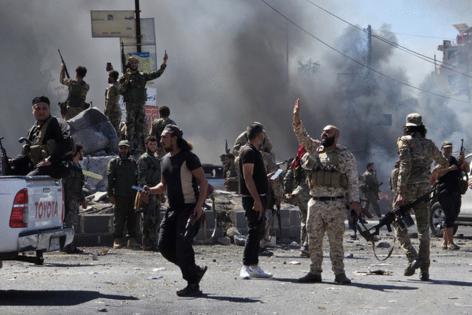Analysis: Syria's sectarian clashes, Israeli airstrikes and a wary peace -- What to know
Published in News & Features
BEIRUT — More than a week of sectarian bloodshed in Syria has given way to a wary truce, pausing a fight that drew Israel into an unprecedented confrontation with Syria’s new authorities while raising fresh questions on whether those leaders can steer the country past the fractures of its 14-year civil war.
The fighting in Sweida, the southern province bordering Jordan and near Israel, began last week between militiamen from the Druze religious minority and Sunni Muslim tribes. It soon embroiled Syrian government forces and Israel in a chaotic battlefield that saw hundreds killed — some in sectarian-fueled revenge attacks — and more than 128,000 people displaced before a U.S.-backed ceasefire was announced Sunday.
The violence underscores the challenges facing the government of President Ahmad al-Sharaa, a rebel-turned-politician whose armed faction spearheaded the ouster of Syrian dictator Bashar Assad in December. Since then, Al-Sharaa’s Islamist-dominated government has struggled to win the trust of minority communities in the country and failed to persuade militias formed during the civil war to disarm or fall under Damascus’ authority.
Here’s a breakdown of what’s happening in Sweida and why many believe it could derail Syria’s delicate postwar recovery.
How did the clashes start?
Before the fighting erupted July 13, tensions were already high after a spate of kidnappings and robberies between Druze communities in Sweida and nearby Bedouin tribes.
As the unrest grew into open conflict involving Druze militias and armed Bedouins, the government dispatched its forces to stop the fighting. But some Druze leaders said the government aided the Bedouins instead; they also accused government-aligned security personnel of committing sectarian-motivated rampages, looting and executions against Druze civilians.
Druze militias launched a counterattack and retaliated with a wave of killings and kidnappings against Bedouin fighters and civilians. Israel entered the fray with an airstrike campaign targeting Syria’s security forces and tanks, as well as the army headquarters and the presidential palace in Damascus, the capital.
The violence left roughly 1,260 dead, most of them Druze fighters and civilians, according to the Syrian Observatory for Human Rights, a monitoring group based in Britain. It also said government forces carried out summary executions. Included in the death toll are hundreds of state security personnel.
Who are the Druze?
The Druze, who make up roughly 3% of Syria’s population, are members of a syncretic religion that emerged in the 11th century as an offshoot of Shiite Islam. There are roughly 1 million Druze worldwide, more than half of them in Syria, and most of the rest in Lebanon, Israel and the Golan Heights, which Israel has illegally occupied — according to international law — since 1967.
During the civil war, the Druze were largely unwilling to ally with Assad but were wary of the opposition, which was dominated by hard-line Sunni Islamist groups, some of whom viewed Druze as infidels. The Druze formed militias for protection.
When Assad fell, many Druze celebrated. But some spiritual and militia leaders — like other minority communities across the country — remained suspicious of Al-Sharaa and his Islamist past, which once included affiliation with the terrorist network Al Qaeda. They resisted his calls to disarm and insisted they would cede power only to a representative government.
Waves of sectarian attacks have only reinforced their suspicions of Al-Sharaa: In March, government-linked factions massacred about 1,500 people, mostly from the Alawite sect, and in May, clashes in Druze-majority areas near the capital left 39 people dead.
How did Israel get involved?
Israel has entrenched itself in the neighboring country since Assad’s fall, with warplanes launching a wide-scale attack to destroy the Syrian army’s arsenal even as Israeli tanks and troops blitzed into Syria and commandeered villages near the border.
Since then, it has consolidated its presence and operated ever deeper in Syrian territory, justifying the moves as necessary for its security and to stop armed groups, government-aligned or otherwise, from launching attacks on Israel from Syrian territory.
Israel has also imposed what is in effect a demilitarized zone over southern Syria, including Sweida, preventing the Syrian army from establishing its authority over the region.
Critics say Israel is engaging in a land grab aimed at keeping Syria a weak and fragmented neighbor.
Another reason for Israel’s intervention is its own Druze population, a vocal minority of about 145,000 people, some of whom serve in the Israeli military. Over the last few months, Israeli troops have offered assistance to Syrian Druze communities. And when the Sweida fighting began, Israeli Druze citizens demonstrated near the border, calling on the Israeli military to protect their fellow Druze in Syria.
Despite those overtures, many Syrian Druze fear Israel’s growing presence in their areas and have sought a diplomatic resolution to their differences with the Syrian government. Others, such as Hikmat al-Hijri, an influential Druze spiritual leader opposed to Al-Sharaa, have repeatedly called for foreign protection.
What is happening with the ceasefire?
Hours after the ceasefire took effect late Sunday, the Syrian government evacuated about 1,500 Bedouin family members trapped in Sweida city. Druze civilians were to be evacuated at a later time. Other phases of the truce will see the release of detained Bedouin fighters and the bodies of Bedouins killed in the fighting.
Is the U.S. playing a role?
The U.S. was involved in brokering the ceasefire. More generally, Trump administration officials have thrown their support behind Al-Sharaa, lifting years-old sanctions that had all but choked the country’s economy and shepherding diplomatic contacts with Israel.
Speaking to reporters Monday in Beirut, the Lebanese capital, U.S. envoy to Syria Tom Barrack said Syrian authorities needed to be held accountable for violations but “they also need to be given the responsibility that” is theirs.
Earlier, in an interview with the Associated Press, he deplored the killings but said the Syrian government was acting “as best (it) can as a nascent government with very few resources to address the multiplicity of issues that arise in trying to bring a diverse society together.”
He also suggested Israel wasn’t interested in seeing a strong Syria.
“Strong nation-states are a threat. Especially, Arab states are viewed as a threat to Israel,” he said. But in Syria, he said, “I think all of the the minority communities are smart enough to say, ‘We’re better off together, centralized.’”
_____
©2025 Los Angeles Times. Visit at latimes.com. Distributed by Tribune Content Agency, LLC.







Comments